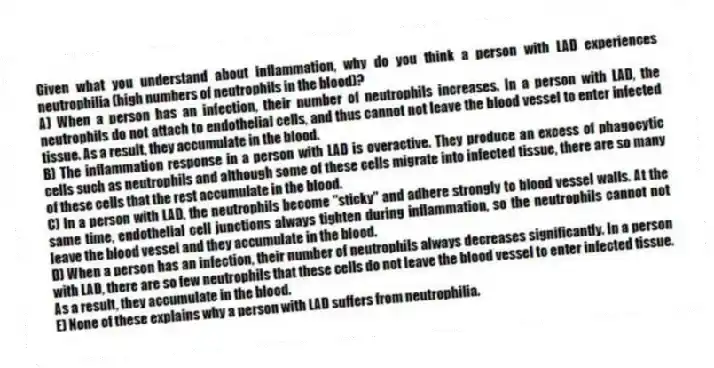
Given what you understand about inflammation, why do you think a person with LAD experiences neutrophilia (high numbers of neutrophils in the blood) ?
A) When a person has an infection, their number of neutrophils increases. In a person with LAD, the neutrophils do not attach to endothelial cells, and thus cannot not leave the blood vessel to enter infected tissue. As a result, they accumulate in the blood.
B) The inflammation response in a person with LAD is overactive. They produce an excess of phagocytic cells such as neutrophils and although some of these cells migrate into infected tissue, there are so many of these cells that the rest accumulate in the blood.
C) In a person with LAD, the neutrophils become "sticky" and adhere strongly to blood vessel walls. At the same time, endothelial cell junctions always tighten during inflammation, so the neutrophils cannot not leave the blood vessel and they accumulate in the blood.
D) When a person has an infection, their number of neutrophils always decreases significantly. In a person with LAD, there are so few neutrophils that these cells do not leave the blood vessel to enter infected tissue. As a result, they accumulate in the blood.
E) None of these explains why a person with LAD suffers from neutrophilia.
Correct Answer:
Verified
Q82: Your first patient of the day is
Q83: Which of the following is NOT True
Q84: Your first patient of the day is
Q85: Your first patient of the day is
Q86: Your first patient of the day is
Q87: Your first patient of the day is
Q88: When microbes are introduced into normally sterile
Q89: Which of the following do you think
Q90: Given the name "leukocyte adhesion deficiency," which
Q92: Your first patient of the day is
Unlock this Answer For Free Now!
View this answer and more for free by performing one of the following actions

Scan the QR code to install the App and get 2 free unlocks

Unlock quizzes for free by uploading documents